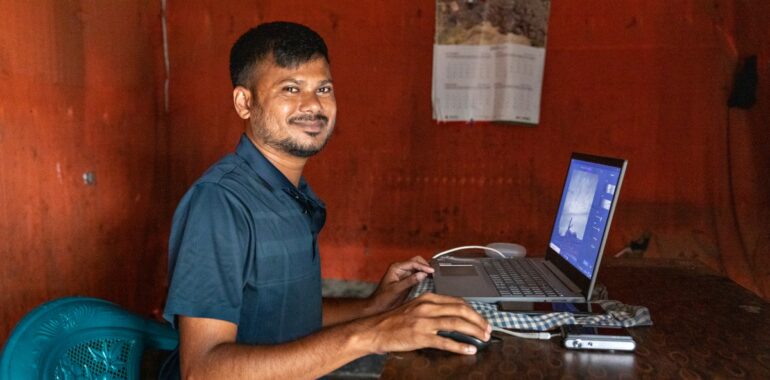In the heart of the Kutupalong refugee camp, where the shadows of hardship stretch far and wide, a young boy named Mohammed Salim Khan grew up amidst uncertainty. Born into a family that had been forced to flee Myanmar in 1992, Salim’s early life was shaped by the struggles of displacement. His parents, like many Rohingya, had been stripped of their citizenship, their homes reduced to ashes, and their future uncertain. Yet, amidst the adversity, they held onto a singular hope: for their children to dream beyond the barbed wire that encircled their lives.
Salim remembers, “Growing up in the camp, I knew the pain of being displaced. But I also saw something powerful in the people around me—resilience, courage, and an unbreakable spirit. That’s when I realised that even though we had lost so much, we could still rebuild. We could still have hope.”
As Salim’s journey unfolded, photography became more than just a passion; it became his way of telling Rohingya community’s story to the world. His lens focused not only on the hardship but on the spirit of hope that refused to be extinguished. “I started capturing the lives of the people around me—people who have faced so much, but still have the strength to smile, to laugh, to dream. I wanted the world to see that we are more than refugees; we are human beings with stories to share and rights to have.”
His images began to gain recognition, and his impact grew beyond the confines of the camp. In 2023, Salim was honoured with the Nansen Refugee Award for the Asia and Pacific region. “It was an honour to receive the Nansen Refugee Award, but it wasn’t just for me. It was for the Rohingya people. It was a way to show the world that despite everything we’ve been through, we are still here, still fighting for our dignity and our future.”
Salim’s work has been featured in prestigious publications like The Guardian, Al Jazeera, and Reuters, and showcased in exhibitions across Europe and Asia. Notable exhibitions include The Next Generation – Young Rohingya Refugees at the Oxford Human Rights Festival and Hostile Environment: The Lives of Rohingya in Venice. “Every photograph I take is a chance to tell a story. It’s a chance to show that despite the violence, despite the fear, we are still here. Our story deserves to be told, not as victims, but as survivors and fighters.”
Beyond his photography, Salim’s commitment to his community is unwavering. He founded the Rohingya Photography School to empower other young Rohingya to pick up a camera and share their own stories. “When I started the photography school, I wanted to give the youth a voice. We have so many talented young people in the camp, and they need to be able to express themselves, to show the world their perspective. Photography is a way for them to be seen and heard.”
For Salim, his mission is clear: to share the resilience and strength of the Rohingya community with the world. “I want people to see us as we are—resilient, hopeful, and full of potential when we have the opportunity. I want to show the world that we are not defined by our refugee status. We are defined by our strength, our courage, and our ability to achieve.”
At Rohingya Centre UK (RCUK), we are proud to highlight Salim’s journey as part of the broader Rohingya story. His work is a reminder that even in the most difficult circumstances, hope can thrive, and change is possible. By sharing Salim’s story, we hope to inspire others to stand in solidarity with the Rohingya, to advocate for their rights, and to support their journey towards a better future.
Salim’s story is not just one of personal achievement—it is a reflection of the Rohingya people’s collective struggle and resilience. “This story is not just mine—it’s the story of every Rohingya. And it’s a story that deserves to be heard, not just for the sake of memory, but as a call to action for all who believe in the power of hope and the importance of standing with the oppressed.”
Follow Salim’s journey on social media:
Instagram: @mohammed_salimk
Facebook: Mohammed Salim Khan
X: @Rohingyasalimkh

